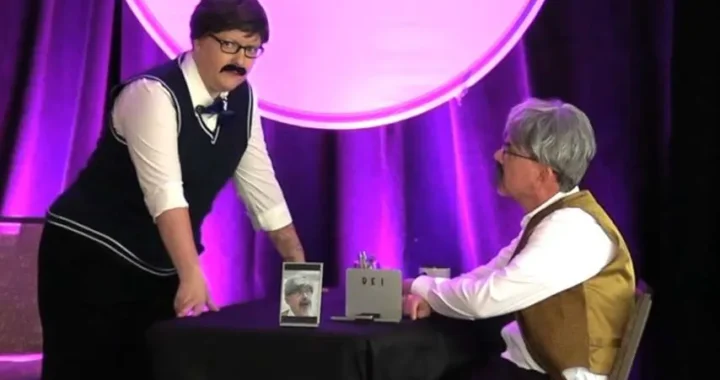In an era of digital fatigue and constant distraction, traditional keynotes—linear, slide-heavy, and emotionally flat—are losing their grip. Meeting attendees today aren’t just looking for content; they’re looking for connection. That’s why some conferences are turning to the theatrical keynote: a powerful fusion of storytelling, performance, and emotional resonance designed not just to inform—but to move.
What used to be relegated to post-dinner entertainment may soon be taking center stage. These high-concept presentations are structured like one or two-person shows, complete with dramatic arcs, comedic timing, and personal vulnerability. They tap into something planners are increasingly recognizing: people will remember how they felt long after they’ve forgotten what was on the slides.
That’s a critical shift, especially as declining attendance and lower budgets are among the top the list of challenges cited in the Meetings Today 2025 Trends Survey. In response, planners are leaning away from passive content delivery and toward interactive, emotionally immersive formats.
Audiences are looking for human connection

This isn’t about fluff. It’s about impact. As Jay Klein, COO of A-Plus Meetings & Incentives, puts it, “It’s always been the case that people go to meetings for personal interaction, not the general session PowerPoints.” Theatrical keynotes deliver on that human element. Instead of being spoken at, attendees are taken on a journey with all the tension, humor, and transformation that great storytelling provides.
But storytelling isn’t just emotional—it’s also instructional. These presentations aren’t lacking in substance; they’re rich with it. The scenes and sketches used onstage are more than just performances—they’re illustrations. Instead of listing best practices, they dramatize them. Instead of telling people what to do, they show how it looks in action. That kind of visual, narrative learning supports a wide range of learning styles.The learning sticks because it’s experienced, not just explained.
Celebrity keynotes aren’t landing for people
And they’re exactly the kinds of experiences today’s attendees prefer. According to a survey by global events company Freeman, only 1% of eventgoers want to hear from celebrity speakers, while 37% prioritize industry experts with meaningful insights. “Attendees want substance, not celebrity,” says Freeman’s SVP of Strategy, Ken Holsinger. “Unless they’re experts in a relevant vertical, celebrities don’t drive behavior.”
In contrast, theatrical keynotes are emerging as a high-ROI alternative—especially when they tap into the power of narrative, humor, and shared vulnerability. They’re less like lectures and more like moments—crafted to resonate, not just inform.
A Theatrical Keynote That Works: Last Mile to Belonging
If you’re still unsure whether theatrical keynotes can truly drive change, or if the word “sketch” makes you nervous in a professional context, the keynote Invisible Differences: Navigating The Last Mile to Belonging might change your mind.
Created and performed by inclusive leadership experts Jason Reid and Kristin Light, this keynote is anything but typical. Combining actionable content with disarming humor and theatrical scenes, Last Mile to Belonging invites audiences to laugh, reflect, and rethink their assumptions about workplace diversity—especially when it comes to invisible disabilities like chronic illness, neurodivergence, and mental health.
Through a series of insightful and hilarious scenes, Reid and Light explore everything from broken hiring systems to the subtle barriers baked into leadership culture. The result? A keynote that’s not just watched—it’s felt.
“I thought it was a wonderfully different way to present important and complex information,” says Shamsia Quraishi of AIA Canada. “The theatrical aspect made it so easy and enjoyable for the audience. It was particularly effective in the afternoon when people are fatigued and overwhelmed with information.”
The feedback is not surprising to Reid , “Before entering corporate leadership, our backgrounds were in screenwriting, performance and acting. We both knew that we could tackle uncomfortable topics better through theatrical scenes than we could through PowerPoint.”
Light agrees: “We’re both natural storytellers, but by creating actual theatre, we can take challenging material and not just make it palatable, but fun. The audience laughs at the characters, but then recognizes themselves or people they work with .That mix of humor, insight and personal connection really sticks with people.”
Audience member Laura Crawford agrees, “Their session wasn’t just entertaining. It resonated on a deep level, and made me really reflect on my leadership style.”
Reid and Light are leading the way in how theatrical storytelling can disarm resistance, humanize sensitive topics, and lead audiences into deeper, more authentic conversations about inclusion.
In a post-pandemic world where in-person events must deliver more than information, theatrical keynotes may prove to be a strategic investment.
..
Interested in booking Reid and Light’s Last Mile to Belonging Keynote? Click here for availability
